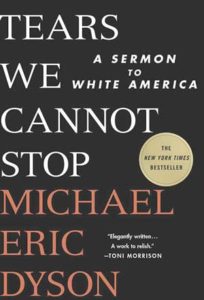Tears We Cannot Stop: A Sermon to White America
Reviewed by David Etheridge
September 1, 2017
 By Michael Eric Dyson. St. Martin’s Press, 2017. 228 pages. $24.99/hardcover; $11.99/eBook.
By Michael Eric Dyson. St. Martin’s Press, 2017. 228 pages. $24.99/hardcover; $11.99/eBook.
Buy from QuakerBooks
Michael Eric Dyson earned his PhD in 1993, but had been ordained as a Baptist preacher 16 years earlier at the age of 19. Tears We Cannot Stop calls heavily on his preaching skills, as he explains early on in the book:
I don’t want to—really, I can’t afford to—give up on the possibility that white America can definitively, finally, hear from one black American preacher a plea, a cry, a sermon, from my heart to yours. If you’re interested in my social analysis and my scholarly reflections on race, I’ve written plenty of other books for you to read. I tried to make this book one of them, but in the end, I couldn’t . . . What I need to say can only be said as a sermon.
Dyson surrounds the sermon with all the standard elements of a Protestant church service: call to worship, hymns of praise, invocation, scripture reading, benediction, offering plate, prelude to service, and closing prayer. The hymns are drawn from music of modern artists such as KRS-One, Lauryn Hill, Tupac Shakur, Jay-Z, Beyoncé, and Kendrick Lamar. He also uses their work as part of a social justice course he teaches at Georgetown University. The scripture readings are from the writings of Martin Luther King Jr.
The preacher begins his sermon by talking about whiteness—not as a biological reality, but as a designation of that part of society with power and privilege over those who are not regarded as white. He notes, “the paradox is that even though whiteness is not real it is still true. I mean true as a force to be reckoned with.” He illustrates the power of whiteness with stories from his own life and recent events such as the Rodney King and O.J. Simpson verdicts.
He next addresses five dysfunctional ways that those regarded as white respond when confronted with the reality that whiteness is simultaneously artificial and powerful. One such response is willful ignorance of how whiteness has caused black suffering—for example, by means of employment discrimination, segregated and inferior housing and education, and racial profiling in the criminal justice system that makes life dangerous and expensive for many people of color and results in their mass incarceration. A second response is forgetting or dismissing the nation’s racist history and its present-day impact. A third is appropriating black culture without having to endure the oppression that helped form that culture. A fourth is historical revisionism—for example, with respect to the causes of the U.S. Civil War or the impact of slavery on the enslaved. The fifth is the dilution of black struggles by making white individuals the heroes of those struggles.
The sermon also describes dysfunctional ways that black people sometimes respond to white racism. Using examples from his own family, he shows how anti-black racism leads to colorism—the favoring of lighter skin over darker—among many people of color. Concerned with how law enforcement gives greater scrutiny and responds more harshly to black misconduct, some black people punish their own children harshly in an effort to prepare them for the world they will face.
The preacher/professor seeks to help white people find constructive responses to the pain (sometimes called “white fragility”) that they often feel when they come to understand the damage that whiteness inflicts on people of color. He describes how he helps his Georgetown University students of all ethnicities both to understand the pain of racism and to explore how best to respond to it.
The “Benediction” section offers a variety of constructive ways to respond. The author acknowledges that reparations is unlikely to be adopted as national policy, but offers practical suggestions on how individuals might do reparations on a personal basis. Individuals can engage black people to perform services for them and pay them slightly better or tip them more generously than normal. They can give scholarships to deserving black students that they know. He suggests establishing an I.R.A., an “Individual Reparations Account,” to fund creative efforts to support the education of individual black people.
Dyson provides an extensive bibliography that can educate us about black history, life, and culture. He encourages white readers who do become educated to educate other white people and become advocates for racial justice. He also recommends visiting black people in schools, jails, and churches. He believes these practices will lead to empathy for people formerly regarded as “other.” He concludes, “The siege of hate will not end until white folk imagine themselves as black folk—vulnerable despite our virtues.”



Comments on Friendsjournal.org may be used in the Forum of the print magazine and may be edited for length and clarity.